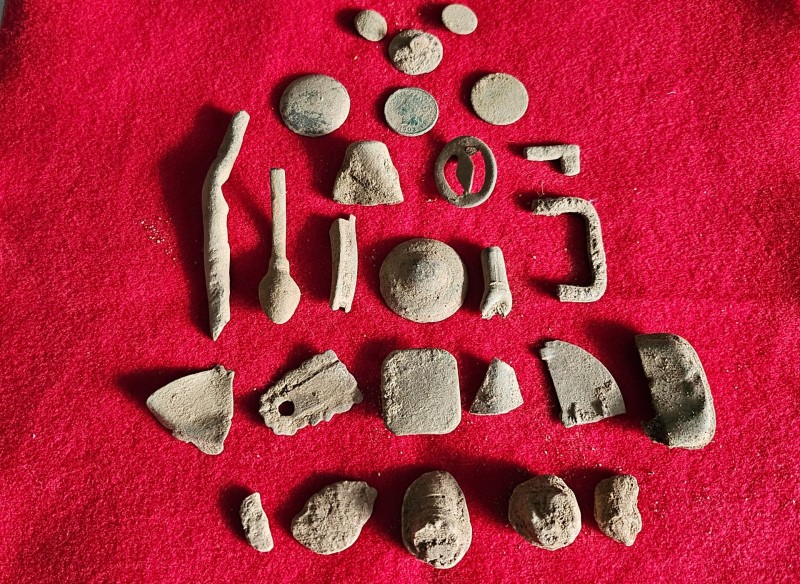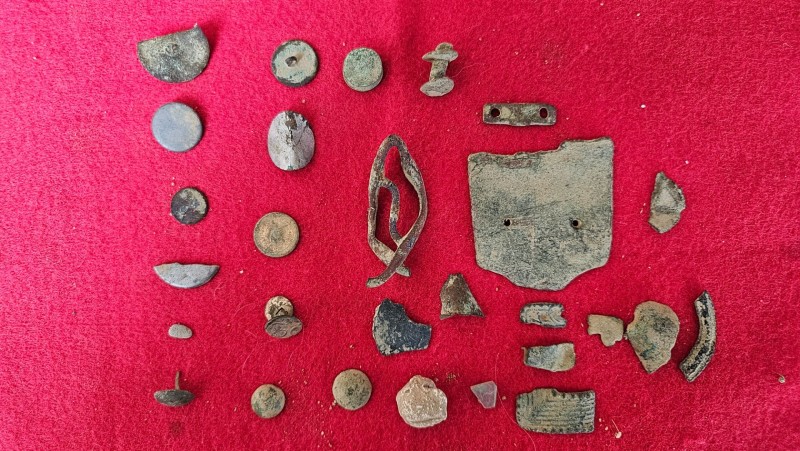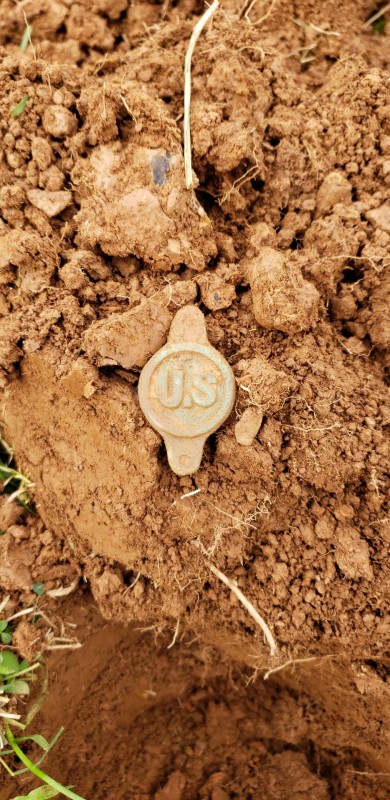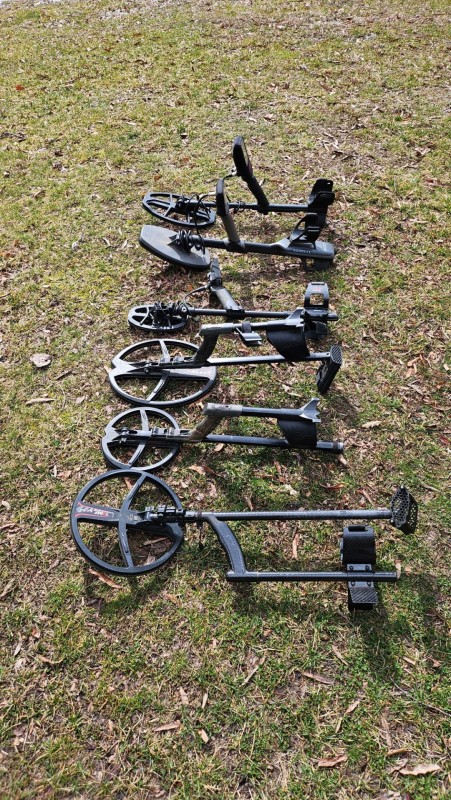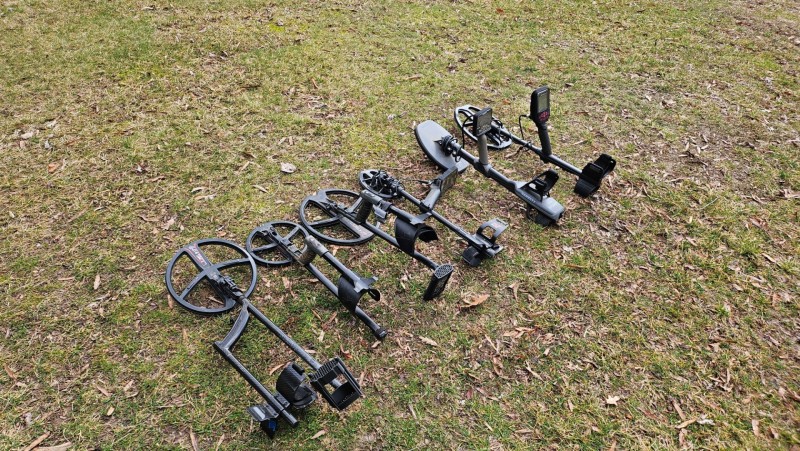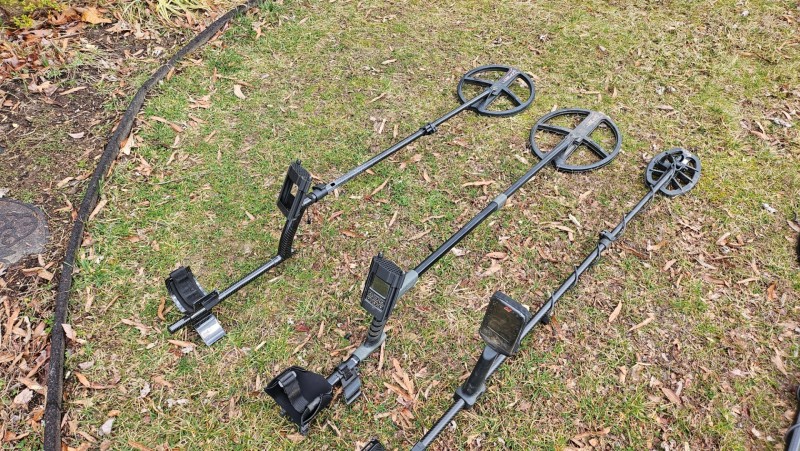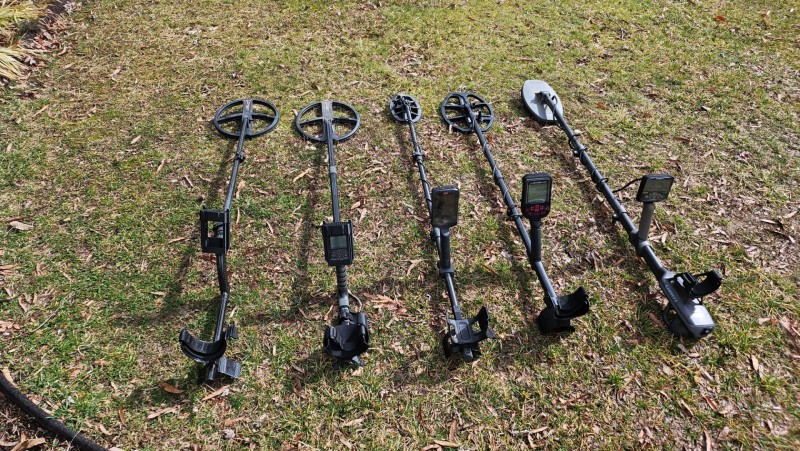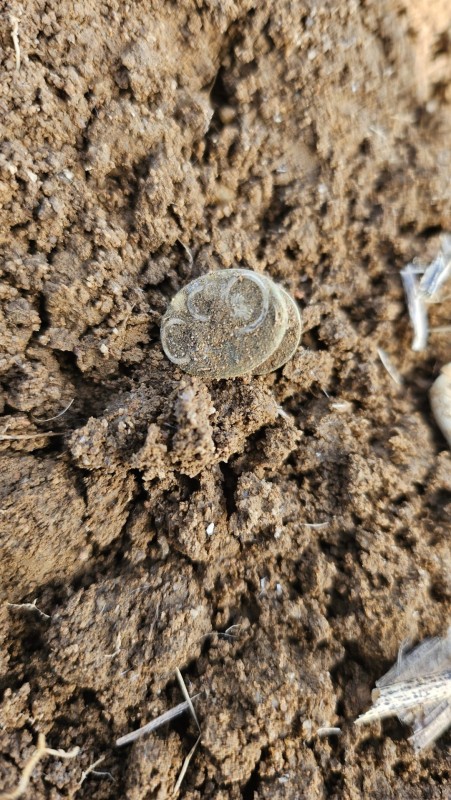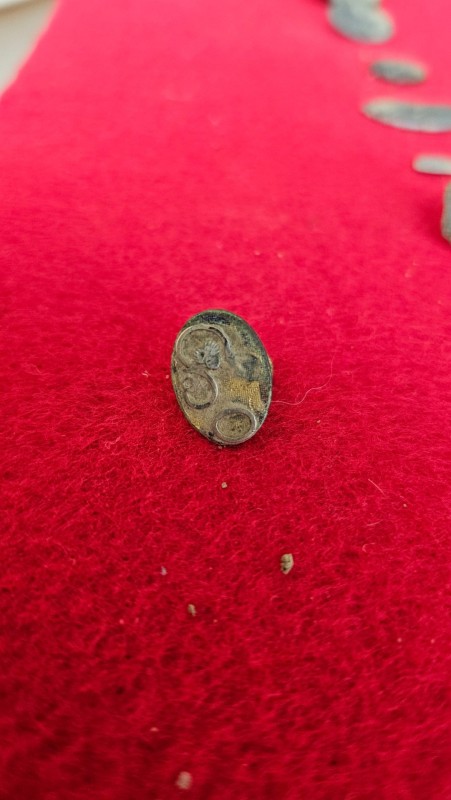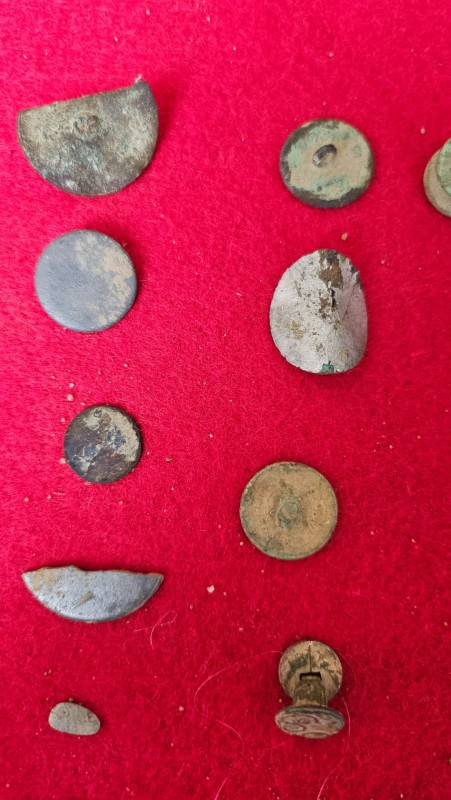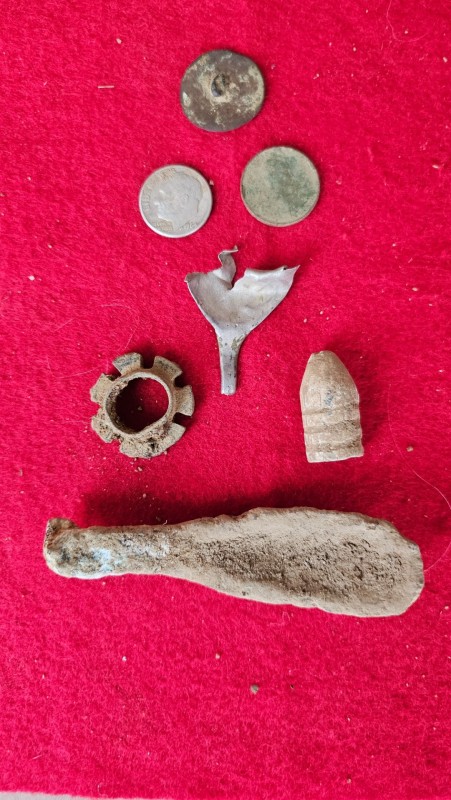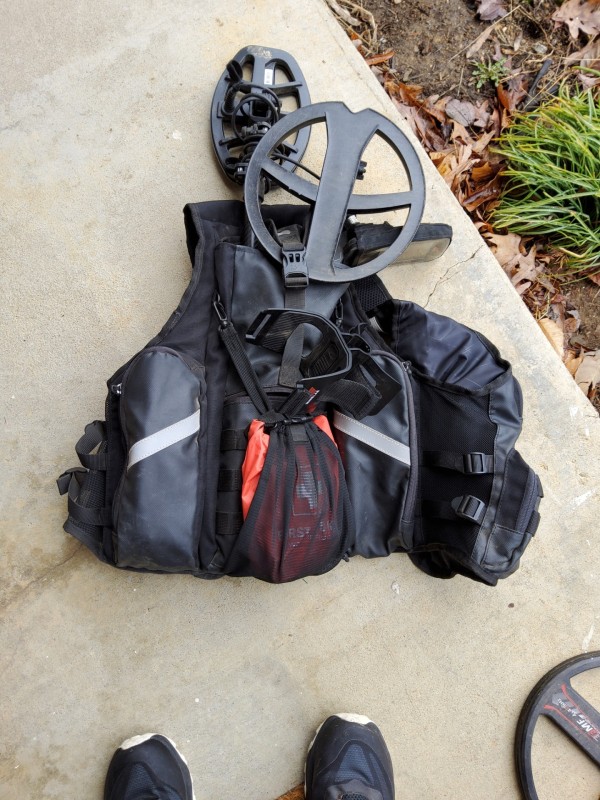-
Posts
6,103 -
Joined
-
Last visited
-
Days Won
32
Content Type
Forums
Detector Prospector Home
Detector Database
Downloads
Everything posted by Chase Goldman
-
To alleviate confusion between cannon bore diameter and standard solid shot diameter/weight and variations in iron alloy specific densities, check the various tables at Historical Publications LLC site https://www.historicalpublicationsllc.com/cannon-bore-shot-shell-canister-and-grape-shot-diameters-for-rifled-and-smoothbore-cannon/article_7776287a-e5be-11ec-a0c1-5b319e800f0a.html. That information is consistent with information posted by L David Keith earlier in the thread.
-
It's likely an adhesive Gore Vent. Internal pressure builds to a point that it temporarily pops the "sticker" to allow the pressure to equalize and then the adhesive re-seals the sticker to maintain a watertight seal. You likely didn't damage it, but if your skin/fingers have oils or other contaminants (silicone grease?) that could compromise the adhesive properties of the vent, then the sealing ability of the Gore Vent "sticker" could be affected leaving the internals vulnerable to water intrusion. That's why you "pop" it into place as shown in the video.
-
Agreed - my relic equivalent mid-conductive targets are primarily brass buttons (though I wouldn't mind hitting another gold coin). But when I said gold, I was looking at it from the perspective of sensitivity to targets smaller than button or coin, and if that is the objective, the M8 might have the edge due to physics (the more closely spaced magnetic field lines it produces) . I feel that it has taken me a full 2 years of experience to get to where I am with the D2. But along with that came two significant D2 updates within the past 6 months that accelerated not only my learning and proficiency but also my success because they actually improved D2 performance and usability namely: The addition of high square audio (1.X) Added audio filter controls (1.X) Enabling iron volume for Full tones (1.X) Enhancing TID stability (1.X/2.0) Improving small, mid-conductive target sensitivity in Goldfield [and Relic]. I think that having the benefit of the latest 2.0 update out of the box will accelerate anybody's D2 learning curve vs. the early adopters who had to wait more than a year between the 0.71 and 1.1 updates. My only caveats against declaring a clear winner here for me: First, I did pretty well on my first hunt with the Manticore/M8 in thick iron. Luck? Non-relevant? Or...will I find even more success with tge Manticore as I learn to be as proficient with it as the D2. Second, it really surprised me on detecting that tiny metallic sliver I found and mentioned in my first post on this thread. Need to do a side-by-side with the M8 and D2 on that target. Finally, while I have A LOT of hot dirt experience with the D2, I basically only have about 3 days with the D2 since ver 1.X came out and zero hot dirt experience with Manticore. I'm still evaluating them both in this regard.
-
Regarding D2 ferrous falsing, Bottle caps, specifically, completely disappear for me on the D2 with the BC filter engaged with little to no downside. You get a blip to know they're there so you're not oblivious to them but can feel free to move on. BC, like D2's Silencer, is just another iron bias type filter. So that's two iron bias filters you can manipulate to potentially knock out multi-alloy ferrous falsing on things like flat tin but TBH I don't have a lot of data to confirm that BC and/or Silencer would be as effective as it is on bottlecaps . Relic program on D2 uses a third, separate type of bias filter called IAR which does a good job of knocking falsing iron back into the ferrous bin while still allowing the non-ferrous to pop. However the D2 Relic/Goldfield programs don't use traditional Disc so don't have access to the Silencer and BC bias filters. That's where technique comes into play - With the D2 custom program slots and quick navigation from program to program, I can quickly hit a target with two or three different setups (programs with different ferrous filter settings) to quickly filter out a false and move on. Ferrous falsing has other tells on the D2. In my experience, the most prominent tell is widely varying TID (especially when you turn on the target) because non-ferrous targets, even those co-located with iron, are pretty stable. I think the biggest D2 falsing weakness is deep large iron, especially large flat iron. Relic/Goldfield appear to be the more "transparent" programs as they are pseudo All Metal, so I search with them in thick iron, and interrogate with "discrimination" Base programs such as General or Sensitive with different tone setups (pitch or full tones) and the bias filters I previously mentioned. To either suppress or coax falsing/distortion to unmask ferrous. Manticore has ferrous limits which is just a different way to slay the same cat using a form of iron bias and appears to also work very well. I am still learning how to use the user programmable hot keys to set up something similar to target interrogation with Manticore to what I have natively with D2. It shows promise. But frankly, all I am doing is getting Manticore to sort of emulate the D2 and not expecting it to surpass the D2. I'm just using its differences to perhaps make some targets pop in iron that I might have missed with D2. ID stability is a minor downside to Manticore compared the D2. On the other hand, I think ferrous limits and the 2-D target trace display on Manticore are better at keeping from getting fooled by big deep iron that occasionally happens with the D2. Steve, from a general detecting standpoint, I look at it this way: Either machine with the small coil (and a proficient operator) is going to probably eek out 8 or 9 keepers out of 10-12 keepers that exist in a given iron patch. It's just that out of those 8 or 9 recovered keepers a couple are going to be different in each batch. That's my gut feel and the reason I feel they "compliment" each other while being effectively equivalent. Sometimes, I just need a change of pace machine I can switch to if I'm in a slump with one machine or the other and it's good they have similar but slightly different performance. Both machines are extremely versatile and with the M8 coil, I think ergonomics/weight end up being a tossup. But to answer your question, for primarily gold, I'd probably lean Manticore. The M8 coil just seems ideal for that. For relics in iron, it's D2 and the 9" coil, but I would be fine working the spot over with M core and the M8 to see if anything else pops. The thing you need to ask yourself, is whether the operator makes the difference. Specifically, is target "interrogation" technique enhanced by D2's features and if that is one of the keys to Condor's success in iron. Similarly, you appear to be more comfortable with the ML platform than with the D2 platform overall. That comfort may be the thing that tips the scales for you in what appears to otherwise be a virtual tie.
-
I don't think you're supposed to peel that sticker as that might be a long term concern regarding adhesion. , You're supposed to actually pop the speaker. Make sure the silicone grease you used was food grade and not petroleum based. This was posted awhile back on how to do the Manitocore/900/7000 battery changeout: Regarding the potential vulnerabilities, warranty should cover it if its a design or manufacturing issue but I am unaware of any drowning issues with the 900 like those reported for the 600/800. HTH
-

Second Hand AlgoForce For Sale Already !
Chase Goldman replied to Tony's topic in AlgoForce Metal Detectors
KFC perfect. For me it would be Taco Bell - same parent company. -

Second Hand AlgoForce For Sale Already !
Chase Goldman replied to Tony's topic in AlgoForce Metal Detectors
Well, it's not designed to have coils swapped, so that would probably be a no or yes? I don't know, but you certainly do, Simon. Though it can be done and third parties sell an adapter shoe to facilitate easier changeout of third party compatible Coiltek coils. Pioneer can confirm this, but I suspect, as he stated, that the ability to swap coils was one reason why he was interested in the E1500 in the first place (over the SDC 2300), as he could then use it for small or large gold hunting depending on the coil and then he could get rid of the SDC and possibly also his Gold Monster. So I am assuming he was using the installed stock SDC coil. Perhaps investing in the coil swap capability for the SDC via the adapter accessory would be the right alternative to the solution he was originally pursuing with the E1500. Even if all the things you addressed, Simon, regarding coil changeout ease and coil cables etc. could be satisfactorily addressed, I think these were less signficant issues and it was the lack of operational automation that really determined that it just wasn't a good fit for Pioneer. He is trying to vacuum up as much gold as he can on a daily basis to make a living and is simply more comfortable with machines that don't need to be tweaked for optimal performance, like the Gold Monster and SDC 2300 (both of which he owns) and perhaps even the GPX 6000 would be in that category, but is out of financial reach. It was good to hear his perspective first hand and even better that he took the time to feed his thoughts back to the company even after he knew the machine was not going to work out for his situation. Also glad he chimed in here and hope to hear from him again regarding his experiences pursuing gold. -
Perspective: I am relic hunting, primarily in mild ground but have a lot of mineralized ground experience with the D2. Very little with the Manticore, though, because I have been waiting for the M8 coil which I just received in late December. I don't like to detect mineralized ground with a VLF with coils with footprints larger than the D2's 9". Ideal footprint would be the 10x5. The M8 is a good option (8x5.5), though a greater coverage footprint (10x5) or 11x6 would be ideal. I have no experience detecting natural gold. I have been frequently detecting a productive Colonial home site with my digging buddy that has multiple thick iron patches hiding relics going back to the 1600's. We have been pounding the hot spots with D2's with the 13" coil (fringes and open field searching) and 9" coil to pick keepers out of the heart of the iron patch. I recently decided to give it a go with the Manticore M8 coil and had success similar to that I had with the D2 and the 9" coil. I know Steve has seen my post on this, but for those of you with the same question as Steve but have not seen it, you can find it here. As far as comparative coil separation performance is concerned, it is hard for me to say with certainty because the detectors are different, plus I have less experience with the Manticore than I do with the D2, but I would say they were at least equivalent. But I can say, that overall I felt almost like I was using the D2 in a new mode. It took a little time to get used to the different target IDs and ferrous falsing "tells" (I think I can mitigate this with a more customized ferrous limits setup - but did just fine utilizing the 2-D target trace display as an additional source of information to make a dig decision). I primarily use the Deus 2 in Relic Mode with sensitivity usually above 90 (sometimes I reduce it to the mid-to-low 80's to "sift" for non-ferrous amongst really thick iron) with high Iron Amplitude Rejection settings (IAR either at 3 or 5) and adjust reactivity as needed. I had the Manticore set up in AT General with Enhanced audio, Default tone settings (2-Region, All tones, variable pitch). After noise cancelling and ground balancing, I set sensitivity at about 23 and left recovery speed and discrimination and ferrous limits at the defaults. Below are my keepers from two different hunts at the same site. The first picture is with the D2 and the 9" coil and the second is the Manticore and the M8 coil. You can see the similarity of the recoveries from the same area but with the different detectors/coils. None of the targets are particularly tiny, but notice the small target in the bottom photo in the column all the way to the left, second target up from the bottom. I am pretty sure that is a tiny piece of silver. It kind of blew me away, but the audio on the Manticore left no doubt that there was a target there. I did not test it with the 9" and Deus 2. Maybe I will do that. I have found broken off button shanks with the D2 and the 9" coil. None of these targets, however, qualify as anything close to micro gold targets. Preliminary Conclusion: I have yet to find a significant difference in performance that I can attribute solely to the different coils or even to the detectors themselves - I probably need more swing time on the Manticore under different circumstance to be sure. There are some features I like about swinging the Manticore vs. the Deus (the target trace display, horseshoe button, light overall package with the M8 coil) and vice-versa (rock solid target ID stability and repeatability, All Metal feel of Relic Mode, great separation ability and coverage of the 13" coil, and incredible integration and performance of the M6 pinpointer) such that I am now thinking that I have a situation (facilitated by the Manticore's M8 coil) that is somewhat similar to what I experienced with the Deus 1 and Equinox 800. Namely, two excellent detectors that compliment each such that I can't see parting with either. Fortunately, I don't have to, and the fact that they are compact enough that I can bring both along even if I am hiking into a site is a bonus.
-
Rick - I think you take a slight performance depth hit on the these AI coils vs. a DD with the same coil footprint. Since you are getting one anyway, you can be the judge of that if you have any DD coils in your arsenal you might use for mineralized ground or use of the GPX ferrous blanking feature. For relic hunting with the GPX, I have run DD coils exclusively because I primarily solely used (I have a Garrett Axiom now) the GPX in hot ground and I also utilized the ferrous blanking feature with great success. I found the Commander Coils to be best behaved in that regard, but also had good experiences with my Detech 12.5" DD. Anyway, the point I wanted to make was that I have experienced detecting in situations with localized interference that could not be mitigated with a simple frequency scan to find an alternate quiet frequency. Since I did not want to take a perpetual depth hit by running an AI coil full time, what I did was utilize Minelab's excellent "Mono-DD-Cancel" toggle on my GPX 4800 that enabled instant, on-the-fly switching of the DD coil wiring to put it in noise cancel mode. This completely eliminated any common-mode external EMI. As with a normal AI coil, there are no free lunches as far as doing this is concerned. You will take a depth penalty (perhaps 10%?) and pinpointing will be offset to one side and as I recall tones switched from low-high to high-low for high conductive targets. All that being said, I recovered one of my best and deepest relics while operating in this mode (it was a brass 1860's military bit boss that was down greater than 1 foot) - I was using the 11" DD stock Commander coil. The best part was that when I was clear of the localized interference, I was able to switch the coil back to DD mode and restore full performance. That would not be possible with an AI without completing switching to a different coil. Even though you are getting an AI coil for use, in those situations were you might be encountering localized EMI while running a DD coil, you can try this approach on the fly without having to switch in your AI coil. FWIW.
-
Jeff/Steve and everyone else, Agree, tempest in a teapot. Like I said, I appreciate these controlled tests and discussions for what they are and do not discourage them. I, for one, was interested in the PI performance comparison of Axiom vs. GPX because it was tangible apples to apples comparison. But also appreciated the VLF comparative data Jeff provided. So don't hesitate to continue to do provide the information, and call it as you see it (based on the data you collected) Jeff. Folks just need to be careful about making and stating definitive general conclusions based on extrapolation of specific results to other situations beyond what the tester intended, that's all. There are too many variables and too many competing effects.
- 25 replies
-
- 3
-

-
- minelab gpx
- garrett axiom
-
(and 1 more)
Tagged with:
-
Not sure why you disagree with my actual statement, "This PI depth advantage wanes as soil becomes more neutral..." I never said they were equivalent and I never said the PI doesn't "win", as if that really matters. No, I wanted to say what I did say. You are simply restating what I said, not making it any more or less correct. No need to change my words. I personally do not agree it is "significant", but why debate that? There are too many variables involved to make absolute and broad reaching statements to percentages or significance etc. I point to what @Steve Herschbach has posted regarding PI depth vs. VLFs in Mild Soils. Yes, this is TDI to MXT comparison, but the principles are the same and Steve has reiterated this principle in other posts. He typically summarizes it as VLF when you can, PI when you must. The GPX and Axiom do put more power into the ground than the TDI so there will likely be some level of depth gain vs. any deep VLF with an appropriate sized coil. Therefore, while I acknowledge some depth advantage likely exists with the Axiom or GPX to a VLF, the "significance" of that depth advantage is worthy of debate, but I personally find that a waste of time. Yes, you can't dig a target you can't hear or see, miss it by a millimeter in depth or coil coverage you miss might as well miss it by mile. When I detect in hot ground, the PI does come out. But in mild and sandy soils, I find I am getting all the depth I need from my VLF detectors and have no motivation, other than simple curiosity, to swing my Axiom over the same ground despite the prospect of more incremental (my term) depth. Separation, discrimination, and soil features such as clay layers that limit overall target depth, etc. are all things that factor into the PI vs. VLF use calculus for mild soil detecting. Right tool for the job. Perhaps I get too grumpy with the continuing obsession with absolute detector depth or other performance parameter comparisons and the fallacy that there are absolutes that can be broadly generalized across all situations based on specific tests. But that's just me. When I have the rare opportunity to get my detector in the field, I just swing away listen, recover, and learn. I reserve my testing for simple go, no-go operational checks and checks of various features and filters. Nothing more, nothing less. But I'm glad there are intrepid folks here like Jeff, El Nino, palzynski, phrunt and many others who have the wherewithal and patience to do these complex comparison tests and share the results with us - I know many who find this information to be useful. I do as well, to an extent. I interpret them for what they are, a specific finding under specific circumstances. I'm a pragmatist. The quest for absolute truth, as far as these machines are concerned, eludes me.
- 25 replies
-
- 3
-

-
- minelab gpx
- garrett axiom
-
(and 1 more)
Tagged with:
-

Axiom And Carrot Interference
Chase Goldman replied to timbus59's topic in Detector Prospector Forum
Andrew - I'll add my 2 cents, I have the Z-lynk Carrot and it works well with the Axiom. I had also previously invested in the Z-lynk TX/receiver kit so that I could plug in my preferred phones when using Z-lynk with the GPX. So with Axiom, I just use the Z-lynk carrot and plug my phones into the Z-lynk receiver. With the Axiom, D2, and Manticore (I picked up a WM09), I just plug whatever receiver into my phones and attach the Z-lynk or WM09 receiver to my phone headband as needed with a short patch cord. The phones natively accommodate the D2 puck. Yeah, it's not a great look, but I'm not trying to impress anyone out there with my fashion sense. Anyway, I really just wanted to give the Z-Lynk Carrot a thumbs up. -
In moderately mineralized soil. This PI depth advantage wanes as soil becomes more neutral (less mineralized) as was discussed in the thread.
- 25 replies
-
- 2
-

-
- minelab gpx
- garrett axiom
-
(and 1 more)
Tagged with:
-
Gotcha. It just came across as totally dismissing the issue. Also, regarding the FCC certification. There should be no real technical issues, it's just cost and time to get the certification. If a bluetooth radio were involved, that wouldn't actually make it any more complicated as long as was complying to industry standards and using existing approved chipsets vs. some proprietary wireless. It's really the magnetic field emissions and whatever is being thrown out by the CPU in the control box. All pretty straightforward and easy to comply with, it just that someone has to actually do the testing, document it, and submit it then you get to wait for the FCC to get around to approving it. Time and money. I know you know all this, Simon, being an electronics tech professional. Really just a red tape compliance issue than a technical hurdle.
-
It's not a non-issue if someone decides to engage whether it is in Australia or the US. It took a long while for ML to engage Nokta on the Legend. The Legend had been on the street for well over a year. If it involves US patents, remember that ML went after DISTRIBUTORS not just the manufacturers. That puts a deep chill on things. I think it's rather naive to think that ML is just going to sit around and let this happen, whether or not there is a legitimate case. The fact that a former ML design employee is involved makes the issue complicated. That employee should know the boundaries of where ML IP stops and what he totally owns, but that doesn't stop someone from alleging an untoward IP situation and throwing a monkey wrench into distribution until the courts get it sorted. All the while someone is happily continuing to sell their product while the other guy has an injunction against selling theirs. It's not about winning or being right, it's about stalling sales.
-
It's very promising, Gerry, I'll give you that, but strictly from a technical and performance standpoint. However, as a pragmatist, I'll refrain from singing zippity-do-dah until it becomes widely available to USA users at the advertised AUS price point. There are significant hurdles to that still need to be overcome and questions that need answering including inventory, supply chain, and distribution struggles, US regulator certifications, overseas demand and the ever present threat of potential litigation from industry intimidators (whether or not "they" have has a case is immaterial, USA distribution simply opens the door on this possibility (see Quest V60/80 series)), etc. Until those hurdles are addressed and put aside, then it is basically a very promising unicorn with an uncertain arrival. Better than the Nokta PI promises at this point, but as the Quest rollout demonstrated, USA distribution is not out of the woods. Rooting for them, most definitely, but concerned whether they will be able to gain a stable foothold here in the US. Once that happens, then sure, I'll sing a song.
-

Me At Div. One Ewalt Farm
Chase Goldman replied to George Kinsey's topic in Metal Detecting For Coins & Relics
Uh oh. -

Me At Div. One Ewalt Farm
Chase Goldman replied to George Kinsey's topic in Metal Detecting For Coins & Relics
George, did you win the 50-50 raffle? -
The connectors are also completely different between the Nox and Vanquish coils.
-
Bill, Thanks. Regarding weight, balance of the Deus 2, let me provide some additional context and perspective on my "toe-heavy" comments. First of all, setting balance aside, the Deus 2 platform, even with the 13" coil is still the lightest overall detector system out there vs. any other detector rocking a similar-sized coil. Balance is an issue with the 13" coil, but the light overall weight and "S" handle shaft design mitigate those issues somewhat such that it becomes less noticeable as swing. I can still swing the 13" XP coil all day. Furthermore, if I add offsetting weight below the armrest by attaching a pinpointer to my shaft mounted pinpointer holder, I can improve balance. For beach and water work, I use a dedicated SteveG CF carbon fiber shaft system designed for the Deus. This system provides more adjustment for balance and optional accessories such as a balance weight and two different remote control mount designs which also help balance as well as also using a similer "S" handle design. I like the SteveG mount for beach and water for a couple other reasons too - since the entire shaft is CF it can withstand repeated dunking and exposure to water and salt sea environments. It also enables the waveguide needed to operate the XP coil submerged to be routed internal to the shaft to prevent wire snags and a cleaner looking install. It can be retracted into a small profile and has the advantage, being a round shaft, to enable the coil to be oriented as needed. However, the XP shaft system is slightly more compact overall, so I prefer using the XP shaft for field work where I have to lug my detector in with a day pack, etc. See the extended Deus 2 with the SteveG shaft (and 11" coil), the XP Shaft and the 13" coil, and the Manticore with the M8 below. Here are all my current detectors that see actual field work, fully extended, below. Here they are, all compacted, below. I snuck the XP Deus shaft with the OEM remote control mount (vs. the RC Digs cage mount) in there for comparison purposes. In fact, if a detector manufacturer is not providing a system that enables the detector to be retracted for easier transport these days, then I think that puts them behind the power curve compared to today's detectors. Even the Axiom can be compacted for daypack use (and comes with its own pack). Above from top to bottom: Nokta Legend with the LG30 Garrett Axiom with the 11x7 DD ML Manticore with the M8 XP Deus 2 shaft and RC Digs cage with the 13" coil XP Deus 2 shaft and traditional RC mount with the 9" coil Steve G XP Deus shaft system with the RC Digs angled mount and 11" coil. Regarding my "toe-heavy" comments when I started swinging the Deus 2 and 13" coil for the trek back to the vehicles, it was more pronounced and noticeable to me at first because I had been swinging the Manticore with its feather light M8 coil all day. If I had been swinging the 11" coil on the Manticore all day, pulling the D2 out with the 13" coil would have been a whole different experience. The imbalance of the XP D2 with the 13" coil is something you do get used to only because of the light overall weight and less torsion on the wrist during swinging with the "S" handle stem. It's a non-issue with the 9" coil and even the 11" coil.
-
I'm on Ver 2.0 on the Deus 2, and the latest release for the M-Core. It's all anecdotal because it is not documented in the release notes, but both Bob and I have run some comparisons and our general perception is that although the ver 2.0 update of the Deus 2 only explicitly mentioned increasing Goldfield small gold sensitivity and compatibility with the Xtreme Hunter two-box coil, it appears that Goldfield's cousin, Relic Mode was also enhanced and overall TID stability seems even more rock solid and repeatable than in previous iterations.
-
If you have been following my posts and those of my detecting buddy, Bob - AKA F350Platinum, you will see that we have been having a great level of success, especially detecting colonial relic sites, over the past year or so. I attribute that to a combination of gaining more proficiency with the Deus 2, gaining access to some exciting new and productive permissions, and utilizing the latest Deus 2 updates (Version 1.1 and 2.0) which fixed most of the lingering issues with the Deus 2 since its release and added some great new features and performance. Even before these updates, we were having such great success with Deus 2 in the relic fields, coin shooting, and beach hunting, that other detectors just didn't get pulled into action unless we wanted to check something out or run some sort of comparison. I have limited opportunities to detect, so when I do get a chance to detect with Bob, I want to make the most of it and not be out there learning some new detector or messing around with unfamiliar settings. About a year ago, I had purchased the Nox 900. On the surface, ML seemed to have addressed most the remaining shortcomings associated with the Nox 800, improved the shaft system, and added some features like adding Deep Pitch (DP) audio as a feature for all detecting modes. They also changed the Target ID scaling and also enabled compatibility with all legacy Nox OEM and third party accessory coils, including my favorite Coiltek Nox 10x5. All of these changes and the ready availability of the Nox 900 vs. the Manticore and the fact that my 800 was no longer in warranty, convinced me to pick up the Nox 900. Got it into the field, and let's just say, I was not impressed. The main issue I had was getting it to run stable at a reasonable sensitivity level (I like to run just above 20 out of 25 sensitivity). It was really chirpy, especially in DP audio and running it along side the Deus 2 was like night and day. Even after a few other tries, it never quite clicked with me. And it started gathering dust. With the 8X5.5" M8 coil release becoming imminent (or so I thought), I decided to invest in the Manticore over the summer. Took it to the beach, and it was just OK and perhaps also a little chirpy. Again, I simply fell back and continued to swing the Deus 2, while the Manticore sat idle. Finally, a few weeks back, I was finally able to get my M8 coil for the Manticore, and after having much success the last several outings with the Deus 2 13" elliptical and 9" round coils at a our most popular and productive areas, felt that some of the more dense iron patches at these sites could benefit from being scanned with the smaller M8. The area we are detecting heavily is not readily accessible to our vehicles, so we have to hike a ways across a couple of fields to get there. I have a Rhino Skin vest with a sizable and long back compartment that provides the ideal setup to carry detecting gear (either my Deus 2 and its two coils or the Manticore with the M8), food, water, and "just in case" items for several hours of "unsupported" detecting. Above, you can see my Rhino Skin vest/pack holding the Manticore and M8 coil and also the XP Deus 2 9" coil/shaft. This was going to be the Manticore's first relic hunting field test. Despite, the limited swing coverage of the Manticore with the M8 coil, I decided to go ahead and make the trek to the detecting area swinging the Manticore. For this session, I decided to keep it simple. I had the detector set up in AT General with Enhanced audio, Default tone settings (2-Region, All tones, variable pitch). After noise cancelling and ground balancing, I set sensitivity at about 23 and left recovery speed and discrimination and ferrous limits at the defaults. I was not walking slow enough to ensure sufficient coil coverage, but targets are few and widely scattered so I was not expecting to recover anything except by chance. Mainly, the walk afforded an opportunity for me to get used to the Manticore tones, ferrous tones, ground feedback in horseshoe (no discrimination) and responsivity again as I had only briefly used it beach hunting and run through various settings in only my test garden. On the trek, I recovered a couple pieces of miscellaneous brass and a modern bullet casing. Met up with Bob in the field who was already there and who was detecting some fringe areas with little success. We started to make our way over to the area and my first keeper target was a fired musket ball. We zig-zagged to different parts of the hot spot area and thick iron and started to do our thing. I recovered some horse saddle brass and more miscellaneous brass pieces. Then the buttons started to pop, brass, gold gilt, silver plate and tombac. I also dug some larger brass (perhaps a partial musket butt plate and a mangled buckle). My final Manticore keeper was a gold plated cufflink (complete with the post and toggle clasp) with an interesting flowering vine design. The Manticore M8 did not disappoint. I had an outing with similar results to my previous trips to this area with the Deus 2. I like the expressive audio, the ability to quickly switch discrimination off and on using the trusty horseshoe button to lessen audio fatigue, the additional information provided by the 2-D target trace display, and obviously the slightly improved separation ability of the M8 coil vs. the Deus 9" round. I got used to the different target IDs, the ferrous falsing tells, and target trace clues to make dig decisions. But frankly, the keepers were pretty obvious, and I dug little junk that fooled me. Finally, the Manticore ergonomics with that M8 coil are fantastic, to the point that once I started swinging my Deus 2 with the 13" elliptical coil again, I really felt the weight and toe-heavy balance. For the trip back to the vehicles, I switched back to the Deus 2 with the 13" coil for better coverage of the large fields and managed another flat button and a rivet and some modern bullets. We quickly surveyed a new site to finish the day and I managed to recover a few surprises from that field, which was had a lot of iron contamination - apparently an old house site. I snagged a .52 Sharps minie ball, a silver Rosie ('64), a flat button, a wheatie, a portion of a tiny silver spoon, and a part of a parasol slider mechanism. All in all, not bad for a first relic outing with the Manticore - I have a lot more to learn and tweak - and not a bad quick survey of a promising new field. The perfect detecting weather, great company, and awesome finds made for another fantastic detecting day. As is our tradition, Bob and I reviewed the day and tentatively planned future adventures while drinking his awesome post hunt coffee. His ornate sword guard and British Colonial period regimental button were really the finds of the day. Bottom Line: Bob has some amazing Colonial sites and the Manticore and M8 coil certainly did not disappoint in a challenging iron environment...looks like I will be bringing both the Manticore and Deus 2 along on future digs.




